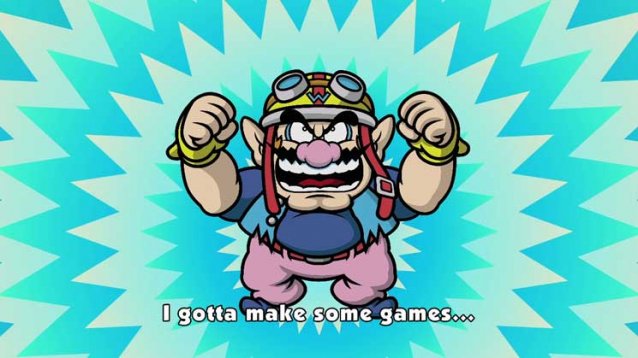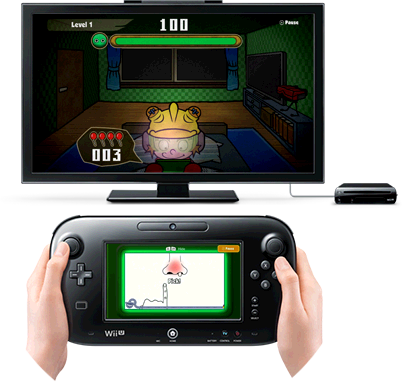


Game & Wario is not a WarioWare game, and if you buy it with the expectation that it will be then you'll probably be disappointed. If you go into it with no preconceptions about what a Wario game should be like, however, you'll find that the game has a lot to offer. It's just a shame that it might not reach the market for which it's intended.
The collection of games that makes up Game & Wario originated as software to be preinstalled on the Wii U console, intended to show off the features of the GamePad, but when that collection became too big the team decided to turn the game into a standalone title instead. Given that, you might expect Game & Wario to feel insubstantial, but that decision was made long enough ago that the team has had time to properly round out the games since then. The decision to brand the collection as a Wario game came later, however, which is why the game doesn't feel much like what you'd expect from a Wario title.

As a collection of games to show off the GamePad, however, Game & Wario works well. Each of the sixteen games focuses on a different feature of the GamePad, so that none feels like a repeat of any of the others. Camera (called Shutter on the website), for instance, has you use the GamePad like a camera, holding it up and “looking through it” at the television screen. You play the role of a photojournalist – Mona from previous Wario games – and must search scenes for targets to photograph for the newspaper. The viewfinder on the GamePad screen lets you zoom in to better see what you're looking at, so you can't just rely on the TV screen and do have to move the GamePad around. It's a gimmick, sure, but it is the kind of physical experience you won't get to have on other consoles.
Ski, however, has you hold the GamePad vertically and tilt it to steer Jimmy T (another WarioWare character) through the course. Again, what you see on the GamePad – a simple top-down view of the slope – differs from what you or onlookers can see on the television screen. The best case of this is in the game that those who are familiar with the WarioWare games will enjoy most: Gamer. In this game, the existence of a second screen provides tension, as you try to perform one task on the GamePad while trying to keep an eye on the TV screen as well. You are a small child playing his handheld console past his bedtime. In fact, you're playing old WarioWare microgames on your GamePad. But at the same time you have to watch out for your mother, and hide if she looks like she's going to pop her head around the door or through the window or even – in a way reminiscent of a horror movie – appear on the kid's TV screen.

The discrepancy between the TV screen and the GamePad screen is put to particularly good use in the multiplayer games. Unfortunately, only four of the sixteen games included in this collection are technically multiplayer, which might put people off, but again any disappointments will come not from the quality of the game but from expectations as to what a Wario game should be like. As a whole, Game & Wario is set up to encourage group play through providing more physical party-style experiences rather than multiple controllers and high-stakes competition. While the game is split into single- and multi-player sections, the line is blurred. Some of the single-player games are more personal – you might, for instance, play through the jigsaws in Patchwork on the GamePad while somebody else uses the TV – but others encourage input from onlookers. While you look through your “viewfinder” in Camera, others can scan the whole scene on the TV; while you play your WarioWare-style microgames on the GamePad in Gamer, others can keep an eye out for your eagle-eyed mother.
As far as the multiplayer games are concerned, not one of them requires extra controllers. This is obviously a huge bonus for families who want a game for everyone to play together but have no desire to spring for up to four Wii Remotes, but it also fits in with the kind of multiplayer experience that Game & Wario encourages. In Islands, for example, you are playing competitively, trying to knock out the other players' tokens in a cross between darts and boules, but instead of each concentrating on one controller and one corner of the screen you take turns and share the GamePad around. A lot of multiplayer video games seem counterintuitive to the camaraderie they seem to promote, as each player largely ignores the others until the scores are in. Here, everyone pays attention to what everyone else is doing, and the atmosphere is more like that of a board game, encouraging interest in and conversation with other people.

This goal on the part of the creators to get people concentrating on the same thing rather than their own games within the game is also reflected in the other multiplayer games. In Fruit, again, only one person has a controller and the others all focus on the same goal, in this case trying to spot which character on screen the GamePad player is actually controlling, i.e. which is the thief stealing the fruit. Instead of pressing a button on their own controllers, the players each take the GamePad in turn once the round is up and make their guess, and the game announces the winners at the end. Of course, each player has her own goal in that she wants to guess correctly and have the others guess wrong, but still everyone is paying attention to the same scene in the same way.
With games like Sketch, a Pictionary clone in which the GamePad acts as a sketchpad, it's obvious that the team behind Game & Wario wanted to provide a way for families to use the Wii U as a tool to enhance the kind of play that families have engaged in for years. Like Nintendo Land, this is a party game, one to get out when relatives visit for the holidays. One or two of the games sacrifice fun for the purpose of showing off the GamePad – Design, for instance, wants to show you just how smart the GamePad is by challenging you to draw lines of various lengths like you're back in your first year of Math classes – but overall they're varied enough to keep a group of players happy for a couple of hours at a time.
Game & Wario was developed and published by Nintendo. It will be released on June 23, at the MSRP of $39.99. A copy was provided by the publisher for the purposes of review.




 How to use Pokemon Omega Ruby and Alpha Sapphire Poke Balls, Location and All You Need to know about Poke Balls
How to use Pokemon Omega Ruby and Alpha Sapphire Poke Balls, Location and All You Need to know about Poke Balls Dead Rising 2 Guide
Dead Rising 2 Guide Grand Theft Auto 5 Walkthrough
Grand Theft Auto 5 Walkthrough Mission 10 - Enemy Lines: Halo 5 Guardians Guide
Mission 10 - Enemy Lines: Halo 5 Guardians Guide Deep Down Wiki – Everything you need to know about the game .
Deep Down Wiki – Everything you need to know about the game .